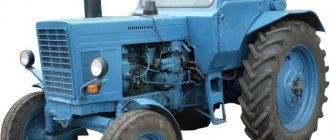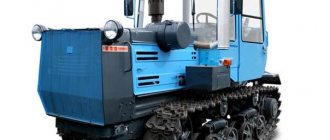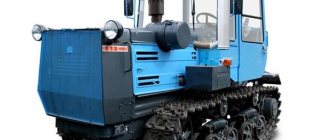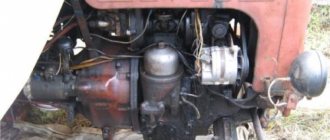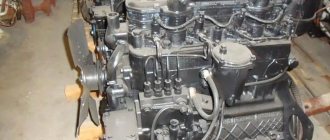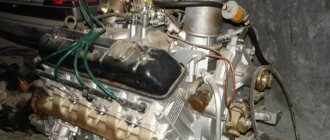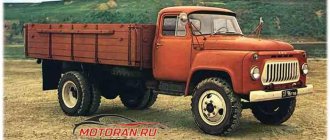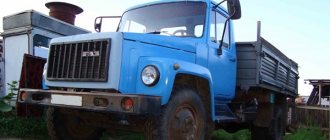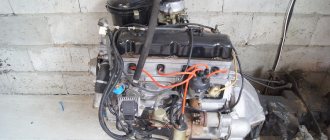Multifunctional medium-boosted UD engines, produced by the Ulyanovsk Motor Plant (the abbreviation UD stands for “Ulyanovsk Engine”) since 1952, were used to drive various small-scale mechanization equipment, as well as in gasoline-electric units of the AB type. In general, the UD engine is a classic four-stroke air-cooled gasoline engine. Initially (1952), the plant mastered the serial production of three modifications with a lower valve arrangement:
- UD-1 is a single-cylinder power unit with a cylinder capacity of 305 cubic meters. cm, developing a power of 4 l. With.;
- UD-2 - 2-cylinder engine, the power of which was 8 liters. With. (cylinder volume 610 cm3);
- UD-4 is a four-cylinder engine with a cylinder capacity of 1220 cc. cm. It developed a power of about 15 hp. With.
Then (1967) more modern power units with overhead valves were launched into production:
- single-cylinder UD 15 (power 6 hp);
- two-cylinder UD 25 (power 12 hp).
Depending on the purpose, the UD series motor was equipped with a variety of attachments, among which one could find:
- Electric starter.
- Reverse gearbox.
- Flange for connecting gearbox, etc.
Specifications
During Soviet times, UD 2 was the most popular power unit among craftsmen who were able to independently assemble a mini-tractor, motorboat, etc. Its operational and technical parameters are shown in the table.
Download .xls file
xls
Download picture
Send by email
| OPTIONS | MEANING |
| Power, l. With. | 8 |
| Cylinder volume, cm cubic. | 610 |
| Number of cylinders | 2 |
| Cylinder diameter, mm | 72 |
| Piston stroke, mm | 75 |
| Compression ratio | 5.5 |
| Lubrication system | Combined (spraying + under pressure) |
| Oil | Mineral |
| Volume of engine oil to be filled, l | 4 |
| Cooling system | Air, forced |
| Fuel supply system | Carburetor |
| Carburetor type | K-16V |
| Fuel | Unleaded gasoline A-72, A-76 |
| Specific fuel consumption, g/l. With. hour | 370 |
| Ignition system | Forced (high voltage magneto) |
| Magneto type | M-68B1 right rotation |
| Spark plug | A 10 N |
| Dimensions length/width/height, mm | 550/485/555 |
| Weight, kg | 72 |
| Motor resource, hour | 3000 |
The engine was installed on:
- petrol-electric units AB-4-O/230, AB-4-T/230, AB-4-T/400, AB-4-P/115, etc.;
- drives for small-scale mechanization equipment (compressors, winches, etc.);
- buoy boats, fishing and utility small motor vessels.
Engine 2sd m1 what is it for
In the USSR, over the years, several series of stationary gasoline engines were produced to drive electric generators, pumps, agricultural machines, and charge batteries. These same engines were widely used on small vessels.
Content
- 1 Series "L"
- 2 Series "UD"
- 3 Engine ZID-4.5 (UMZ-5)
- 4 Engine “2SD”
- 5 Engine “SD-60” B/3
- 6 Engine "ODV-300V"
- 7 Modifications of Moskvich engines
- 8 Modifications of GAZ, ZMZ, UMZ engines
- 9 Modifications of ZIL engines
- 10 Notes
- 11 Literature
Series "L" [ | ]
L series engines
(
Leninets
) were developed in the late 30s at the Ulyanovsk Motor Plant and were produced until the early 60s. The series included three engines, unified according to the cylinder-piston group: L-3/2, L-6/2 and L-12, respectively single-cylinder, two-cylinder and four-cylinder. The working volume of the cylinder is 300 cm3. Operating speed - 2000 rpm. Cylinder power 3 hp Engines are carburetor, four-stroke. Cooling is liquid. Lubrication - by splashing.
“L” engines were originally developed to drive electric generators, pumps, etc., but have also found application for boats.
Series "UD" [ | ]
UD
- a brand of multi-purpose small-displacement gasoline internal combustion engines produced by the Ulyanovsk Motor Plant.
stands
for Ulyanovsky Dvigatel
. The engines are four-stroke, air-cooled, with bottom valves. Since 1952, 3 main models and their modifications have been produced:
- UD-1 single-cylinder engines with a power of 4 hp. with bottom valves; 305 cm 3
- UD-2 two-cylinder engines with a power of 8 hp. with bottom valves; 610 cm 3
- UD-4 four-cylinder engines with a power of 15 hp. with bottom valves; 1220 cm 3
Since 1967, the production of two more models of overhead valve engines began, with a design based on the engine of the Zaporozhets ZAZ-966 small car:
- UD-15 - single-cylinder engines with a power of 6 hp. with overhead valves;
- UD-25 - two-cylinder engines with a power of 12 hp. with overhead valves;
Basic engine models at the factory were equipped with various equipment, which was indicated by a letter after the numbers:
- G
- engines designed to drive generators. Equipped with an electric starter and an adapter casing. Magneto with fixed ignition timing. - C
- engines designed to drive small-sized agricultural machines. Equipped with a reduction gearbox. Magneto with fixed ignition timing. - B
- engines for small vessels. They were equipped with a release clutch, a reverse gearbox, a propeller shaft and a propeller, a magneto with an ignition timing regulator. Initially they were water-cooled, but were mass-produced with air cooling (under the brand name PD-221). - T
- engines designed to operate on mini tractors and asphalt rollers. They were equipped with an adapter flange for the gearbox, an electric starter, a paper air filter, and a magneto with an ignition timing regulator (also produced under the SM-12 brand). - M
- modernized engines with accelerated working process [1].
These engines were also produced by other factories under the PD
,
SK
and UD at the Petropavlovsk Small Engine Plant (Petropavlovsk, Kazakhstan) [2] and
SM
at (Kharkov, Ukraine). Engines are quite common; the number of mentions of the family on the Internet is several times greater than for the other listed one-two-cylinder engines combined [3].
The main use of engines is petrol-electric units of the AB series. They were also used to drive small-scale mechanization equipment: microtractors, walk-behind tractors, asphalt rollers, compressors, winches, pumps, and as stationary engines on utility, fishing, and buoy boats.
UD engines are medium-boosted carburetor engines and are characterized by a specific weight of about 9 kg/hp. (modern stationary carburetor engines similar in cylinder volume and scope of application weigh about 4 kg/hp, stationary atmospheric diesel engines weigh about 7 kg/hp [4]). The heavy cast iron flywheel contributes to the stable operation of the gas-electric unit during sudden load changes. The design of the engines is designed for continuous operation at rated power over a wide temperature range (for example, UD-15 - -50. +50°C). The engine life before major overhaul is about 3000 hours. The factory instructions contain not only instructions for routine maintenance, but also complete information for repairs up to major repairs in any sufficiently equipped workshop (for example, tolerances and fits in the interfaces of all main parts).
In terms of their specific indicators, the UD-15 and UD-25 engines were on a par with stationary engines of similar long-term power developed abroad in the 60s. Subsequently, the designs of foreign engines constantly developed (for example, the first engines of the well-known Honda G/GX series were released in 1977), consumer requirements for them changed greatly. Domestic ones were produced unchanged until the mid-90s. When developing UD engines, we took into account the possibility of production in poorly equipped production facilities (ground casting, low-grade aluminum alloys and steels, increased tolerances and selective assembly, finishing of assembled parts, etc.), operation in harsh conditions (army, lack of qualified current maintenance), the use of mainly only low-grade fuels and oils (gasoline no higher than 76, pre-war “automatic” oils) without strict restrictions on consumption, unification according to components produced by other factories that were already outdated at that time (a primitive carburetor, heavy aggregate magnetos, all-cast iron cylinders). The engines were intended primarily for units transported by trucks of organizations and the army, and also produced without changes for decades. Weight, technological, design improvement of products did not have a direct incentive and were not included in production plans. As a result, by the end of the 80s, with the beginning of mass production in the USSR of small motorized equipment for the consumer market, these engines turned out to be of little use, and then, in the 90s, uncompetitive relative to foreign ones. With the reduction of the military program, the factories either went bankrupt (Petropavlovsk Small Engine Plant in Kazakhstan) or abandoned the production of engines of this class (UMZ). There are references to attempts to modernize the UD in the 90s, but there is no specific information about these works.
When comparing with foreign engines and searching for an analogue, it should be taken into account that for the latter, the “power” characterizing the position in the model range is the maximum power obtained when removing the external speed characteristic with the throttle fully open [5]. For UD
and the like, long-term or “governored power” is often given as a characteristic parameter, and the maximum permissible power is considered to be at certain elevated speeds, limited by the design features of the engine. Foreign manufacturers (Honda, Robin-Subaru) recommend for their engines a long-term power of about 0.8 of the declared maximum [6] [7]. For example, the UD-15 engine develops a nominal “regulator power” of 4 hp. with a maximum allowable of about 6 hp. [8] ; an engine of similar volume in the Honda GX240 has a maximum power of 6.6 hp. and “power at the regulator” 5.6 hp. [9] . Modern production engines, suitable for a full replacement of UD, have approximately one and a half times lower specific gasoline consumption, twice the specific power, use current types of fuel (including gas) and oils, are fully supplied with spare parts, are more reliable in operation (less frequent failures) in operation with a comparable service interval), their maintenance and repair are less labor-intensive.
Engine ZID-4.5 (UMZ-5) [ | ]
- carburetor, four-stroke, single-cylinder, air-cooled and cylinder displacement 520 cm 3;
- piston stroke 90 mm;
- cylinder diameter 86 mm; compression ratio - 5.3; rated power - 4.5 hp;
- The crankshaft speed at this power is no more than 2000 rpm.
Description
The UD 2 engine is a 4-stroke power unit with a bottom valve arrangement. The basic element of the engine is the crankcase, consisting of two body parts connected to each other. Inside it are installed parts of a crank mechanism that converts the reciprocating movement of the pistons into the rotational movement of a solid forged crankshaft.
The connecting elements between the pistons and the crankshaft are solid forged connecting rods, which have an I-beam cross-section. Each of them is connected to the corresponding piston by a special piston pin. The piston walls have grooves in which one oil scraper ring and two compression rings are installed.
Critical parts of the mechanism were made from:
- high-strength cast iron – cylinders, flywheel;
- aluminum alloy – pistons, cylinder heads.
A heavy flywheel mounted on the front extension of the shaft facilitates the removal of the connecting rod and piston group from the “dead spots” and, in addition, ensures the supply of cooling air to the cylinder head and directly to the cylinders. For this purpose, it is equipped with figured blades. The external drive coupling is installed on the rear side of the shaft.
The carburetor, fuel tank and air filter are mounted on the outer surfaces of the crankcase. Gasoline enters the carburetor by gravity from the tank, and the air filter cleans the air that enters the cylinders from dust. The crankshaft speed is controlled by a centrifugal governor, which controls the carburetor throttle valve.
Stationary gasoline engines made in the USSR
In the USSR, over the years, several series of stationary gasoline engines were produced to drive electric generators, pumps, and agricultural machines. These same engines were widely used on small vessels.
Content
- 1 Series "L"
- 2 Series "UD"
- 3 Engine ZID-4.5 (UMZ-5)
- 4 Engine “2SD”
- 5 Engine "SD-60"
- 6 Engine "ODV-300V"
- 7 Modifications of Moskvich engines
- 8 Modifications of GAZ, ZMZ, UMZ engines
- 9 Modifications of ZIL engines
- 10 Notes
- 11 Literature
Series "L" [edit]
L series engines
were developed in the late 30s at the Ulyanovsk Motor Plant and were produced until the early 60s. The series included three engines, unified according to the cylinder-piston group: L-3/2, L-6/2 and L-12, respectively single-cylinder, two-cylinder and four-cylinder. The working volume of the cylinder is 300 cm3. Operating speed - 2000 rpm. Cylinder power 3 hp Engines are carburetor, four-stroke. Cooling is liquid. Lubrication - by splashing.
“L” engines were originally developed to drive electric generators, pumps, etc., but have also found application for boats.
Series "UD" [edit]
UD
- a brand of multi-purpose small-displacement gasoline internal combustion engines produced by the Ulyanovsk Motor Plant.
stands
for Ulyanovsky Dvigatel
. The engines are four-stroke, air-cooled. Since 1952, 3 main models and their modifications have been produced:
- UD-1 single-cylinder engines with a power of 4 hp. with bottom valves; 305 cm 3
- UD-2 two-cylinder engines with a power of 8 hp. with bottom valves; 610 cm 3
- UD-4 four-cylinder engines with a power of 15 hp. with bottom valves; 1220 cm 3
Since 1967, production of engines of two more models began:
- UD-15 - single-cylinder engines with a power of 6 hp. with overhead valves;
- UD-25 - two-cylinder engines with a power of 12 hp. with overhead valves;
Basic engine models at the factory were equipped with various equipment, which was indicated by a letter after the numbers:
- G
- engines designed to drive generators. Equipped with an electric starter and an adapter casing. Magneto with fixed ignition timing. - C
- engines designed to drive small-sized agricultural machines. Equipped with a reduction gearbox. Magneto with fixed ignition timing. - B
- engines for small vessels. They were equipped with a release clutch, a reverse gearbox, a propeller shaft and a propeller, a magneto with an ignition timing regulator. Initially they were water-cooled, but were mass-produced with air cooling (under the brand name PD-221). - T
- engines designed to operate on mini tractors and asphalt rollers. They were equipped with an adapter flange for the gearbox, an electric starter, a paper air filter, and a magneto with an ignition timing regulator (also produced under the SM-12 brand). - M
- engines modernized in the 90s.
Maintenance
UD engines, like any other internal combustion engines, require regular maintenance (MOT). In this case, they distinguish:
- Shift maintenance.
- First maintenance.
- Second maintenance.
Shift maintenance comes down to checking before each start of the power unit:
- engine oil level;
- no oil leaks;
- reliability of fastenings of parts and assemblies.
After starting the engine, you need to check the engine oil pressure and make sure there are no extraneous sounds or knocks inside the engine. At the end of the work, it is necessary to drain the contents of the fuel tank sump.
The first maintenance is carried out after the first 50 hours of engine operation. In this case it is necessary:
- change the air filter;
- change the oil filter element;
- change the engine oil;
- wipe the timing valve;
- clean the combustion chambers and pistons from carbon deposits;
- check timing valve clearances;
- check the contact gaps in the spark plugs;
- Clean magneto contacts.
In the future, these procedures (TO-2) are recommended to be carried out every hundred hours of operation. In addition, it is recommended to regularly clean the crankshaft of sediment accumulated in the connecting rod journals.
Carter
Multi-electrode glow discharge indicators of the In series, technical characteristics, parameters, description
The main part of the UD-15 engine is the aluminum crankcase with a tunnel design. It houses a separate front crankshaft bearing housing that is bolted on. In the front wall of the crankcase there is space for installing a gear pump and a pressure reducing valve for regulating the pressure in the lubrication system. On the outer side of the crankcase there is an axis for the foot pedal to start the engine.
The design of the engine crankcase provides a ventilation system through a special valve located near the magneto drive. The gases that break into the crankcase enter the rubber pipeline through the valve and then into the engine air filter.
Malfunctions
UD power units are characterized by a number of typical defects (see table).
| FAULT | CAUSE |
| Starting the engine is difficult or impossible. | Defects in the fuel supply system; The ignition system is faulty. |
| The engine does not develop the required power. | Ignition adjustment is broken; the jet is clogged; timing valve clearances are broken; The tightness of the gas pipeline is broken. |
| Extraneous knocking noise in the engine. | The ignition timing is incorrectly set; the presence of carbon deposits in the combustion chambers; the flywheel has become loose; parts of the connecting rod and piston group are worn out. |
| The engine gets very hot. | The ignition is not adjusted; the motor is overloaded. |
| Compression in the cylinders has decreased. | Wear of piston rings; timing valve clearances are broken; The cylinder head gasket was blown. |
Application today
Three-phase motors in a single-phase network: connection diagrams and selection of capacitors
Stationary UD-15 engines were widely used on various agricultural machinery, for example, on the MTZ-05 walk-behind tractor. In addition to Ulyanovsk, motors were assembled at factories in Petropavlovsk (Kazakh SSR) under the designation PD or SK and in Kherson - under the designation SM.
Currently, engines are quite widely used on homemade equipment - tractors and motor boats. The photo below shows a homemade walk-behind tractor.
Reviews about the UD-15 engine are mostly positive. One of the main conditions for trouble-free operation of the engine is timely and regular maintenance by cleaning the engine fins from dirt. The only drawback is the lack of high-quality spare parts, so many engines are dismantled for donor parts.
Tuning
The UD 2 power unit, in the opinion of many owners, is quite capricious during operation. Therefore, it is quite often subjected to various modifications, which, by and large, can hardly be called tuning. However, they add stability and reliability to its work. The following modifications are most often carried out:
- reduce the volume of combustion chambers;
- rework the intake manifold;
- modify the lubrication system, making it full-flow;
- The magneto is modified by replacing the high-voltage coil with an ignition coil from a car.
Military gas generator with 2SD M1 engine
Pokazuvati elementi keruvannya progravachem
- Published 2nd 2015
- generator with an engine from Minsk, with a power of just over 1000 watts, load test www.youtube.com/watch?v=1dhnA.
COMMENTS • 309
There is no ohmmeter on the unit, but there is a voltmeter, ammeter, and frequency meter.
It's not bullshit, it's a thing. I use it myself.
The miracle of carrots, this is in the opposite direction, is far from bullshit for you.
Today they brought me a carburetor from this... I asked where the rest was, they said they dismantled it and handed it over (
We also have one like this from the Soviet era, unfortunately it is not known, only in our version it is a pump, not a fancy device, but a reliable one!
what kind of personalities?
I have almost the same rating only AB2
It's rubbish that what they are selling now is a real, reliable, simple and fuel-efficient army generator.
There is nothing worse when an alarmist shouts at your arm!
This is our home! And now what? Only Chinese woof. O !
hi everyone, can you tell me what kind of capacitor is MKF and VOLT, thanks in advance
It was such crap. Threw it in a landfill
This is not ancient bullshit, this is a future you won't see. The time will come and they will say that the gods did it!
“The time will come and they will say that the gods did it!” not at all . unlikely . It's more like bullshit.
unlike the Chinese ones - this generator was developed in the design bureau
Los motores Rusos se escuchan muy desatiempados de mala calidades lindo escuchar un motor como un Reloj
Judging by the protective box, the gasoline unit was removed from the KShM-1145BM armored personnel carrier; for nuclear vehicles, they came without a box, or even with a lightweight frame made of pipes.
K284SS1
| An extremely rare microcircuit, one of the decorations of the collection. It is an operational amplifier of low accuracy and speed. Information sheet for it. |
|
The main purpose is to use it as an active element in the construction of linear active RC filters in the range of audio and infrasound frequencies. Based on the microcircuit, high-quality filter sections (with a quality factor of up to 150) can be implemented. An additional high-resistance output expands the capabilities of the microcircuit, allowing it to be used when implementing links with relatively low quality factors.
In addition, the microcircuit found use as linear amplifiers in the construction of components for analog computers, etc.
The markings are noteworthy. GOST 18682-73, according to which the series number is written together and not separated by letters, has been put into effect since July 1974. “In the USSR, since July 1974, GOST has been in force, which applies to newly developed and modernized integrated circuits, establishing their classification and symbol system. ... In the MS designation of design and technological series developed before July 1974, the first of three digits appears at the beginning of the type designation, and the second and third after the letter index.” That is, microcircuits of older designs continued to be produced with the same designation until modernization. It turns out that this copy is one of the very first?
The input stage (T1, T2) is built according to a differential circuit with transistor T3 in the source circuits, which is a direct current generator and serves to increase the common-mode component suppression coefficient. The load resistors (R1, R2, R4) in the drain circuit T1 and T2 are chosen to be low-resistance due to the low input resistance of the subsequent stage. The second stage is also made according to a differential circuit, but using bipolar transistors (T4, T6). The collector load of transistor T6 is the GT transistor, which as a dynamic load represents an equivalent resistance having hundreds of kilo-ohms. This inclusion of transistor T5 allows you to obtain significant gain in the differential stage and have an asymmetrical output. The collector of transistor T3 with pin 1 is connected incorrectly; it should be connected to the sources of transistors T1, T2. It should be noted that the imbalance in the resistance of resistors R8, R10 in this circuit does not play a significant role due to the automatic setting of the mode of transistor T5. The output stage of the op-amp, made on field-effect transistor T7 and bipolar transistor T8, is a source follower circuit with tracking coupling, in which the voltage transfer coefficient can be greater than unity.
Lubrication
The lubrication system of the UD-15 and UD-25 engines is identical. The lower part of the engine crankcase is used to store an oil reserve of 1.5 liters (3 liters for a two-cylinder engine). From there it is fed under pressure to the engine bearings and into a centrifuge for cleaning. Purified oil is supplied to lubricate the connecting rod bearings and the gas distribution mechanism. In this case, oil is supplied to the engine valve boxes through the drive rod of one of the valves. The oil drains back from the box through a separate tube. For use in engines, the cheapest mineral oils of summer and winter grades can be used.
There is a mechanical indicator to control the oil pressure. The normal pressure is considered to be a protrusion of the indicator rod of 3 mm. Optionally, a dial pressure gauge MTS-16U can be installed on the engines. There is a hole in the crankcase for its installation, closed with a screw plug. This hole is used to fill in fresh oil. For drainage there is a second plug on the bottom of the engine crankcase.
K2SS842B + (K)284SS2A,B
The K284CC2 microcircuit is a block of repeaters. Its body contains four independent sections (sharing only power circuits): - two complex source voltage followers; - one inverting amplifier (also known as a source follower in another connection); — one emitter voltage follower. The K284CC2 microcircuit is a block of active elements for constructing RC filters. It makes it possible to reduce the size and weight of frequency-selective devices that were previously made on the basis of RCL circuits, and to obtain frequency characteristics in the low-frequency region with quality indicators that are unattainable when using inductors. Field-effect transistors at the input (KP201A,V/2P201A,V) provide a very high input resistance. In this regard, the K284CC2 microcircuit is advantageous to use in the low, and especially infra-low frequency range. The microcircuit can be used not only to implement linear selective circuits, but also to match low-impedance loads with high-impedance signal sources, build amplifiers with high input impedance, build self-oscillator circuits, etc.
Based on the K284CC2 microcircuit, it is possible to design low- and high-pass filters with a roll-off slope of up to 60 dB per octave when the ambient temperature changes from -20 to +55 ° C and with an attenuation slope of up to 40 dB per octave, operating stably when the temperature changes from -45 up to +55°С.
Information sheet, factory booklet, passports for K284SS2 1978 and 284SS2 1991 and data from the industry catalog for it.
Reviews about her on the Internet are interesting; usually very positive:
| “...The K284CC2A microcircuit was chosen because it is practically “indestructible” ...” |
|
The microcircuit contains three active high-quality elements, the input stages of which use field-effect transistors, and one emitter follower based on a bipolar transistor. The input resistance values for all three amplifiers are several thousand megaohms. The maximum amplitude of the signal at the output of each amplifier, at which the harmonic distortion value does not exceed 2%, is no less than 2.5-3 V. The self-noise level of each amplifier does not exceed 10 μV in the frequency band 1 Hz - 40 kHz. Output impedance no more than 75 Ohms. The average value of the instability of the transmission coefficient when the amplifiers are switched on according to the source follower circuit (in this case 0.98<K<1) and the temperature changes from -45 to +55°C is 0.3%.
Microcircuit inside (first pin - top right):
Unpackaged transistors, KP201A + KP201V:
KT332V:
Ignition and starting
The UD-15 engine is equipped with an ignition system from a conventional single-spark magneto M-137 (double-spark M-151 on the UD-25). The design of the unit ensures constant regulation of the angle of the spark supply to the engine spark plug. All magneto components are located in a zinc alloy housing. The drive is carried out from the speed control gear using an additional clutch.
The conventional UD-15 engine is started using a kick starter pedal. The kick starter is a lever with a toothed sector that meshes with a gear on the crankshaft flywheel shaft. This gear is equipped with a ratcheting mechanism that disengages it after the engine starts. The return motion of the starter pedal is ensured by a spring.
Rate this article:
Modifications
All stationary UD units are available in various versions, differing in attachments. The UD-15 engine, which was supplied to customers in the basic version and in the version with the index “G” for driving an electric generator, was no exception. The photo below shows this version of the motor.
The generator version of the engine was distinguished by an adapter bell mounted on the crankcase for mounting the generator and the presence of a ring gear on the flywheel. To start such a unit, an ST-351V electric starter with a voltage of 12 V was used. Another difference between the versions was the spark plugs. The UD-15 engine uses a spark plug model A10N or CH200, and the UD-15G generator motor uses a spark plug CH302-A.
Mixing formation
To power the UD-15 engine, a K-16M or K-45M carburetor is used (on an engine with 2 cylinders). The design of the carburetor allows it to be used in conjunction with a speed controller. Speed regulation is carried out by two spring-loaded balancers. As the speed increases, centrifugal force pushes these balancers apart to a certain point. When it is reached, the balancers begin to move the carburetor throttle valve through the rod, thereby reducing the speed. The governor springs can change the tension force to set the speed.
To supply gasoline from the tank, a diaphragm fuel pump is installed on the engine crankcase. The working drive of the pump is realized from a separate cam on the engine camshaft. A manual drive is provided to pump gasoline into the carburetor when starting. Air filtration is carried out by an inertia filter with an oil bath.
